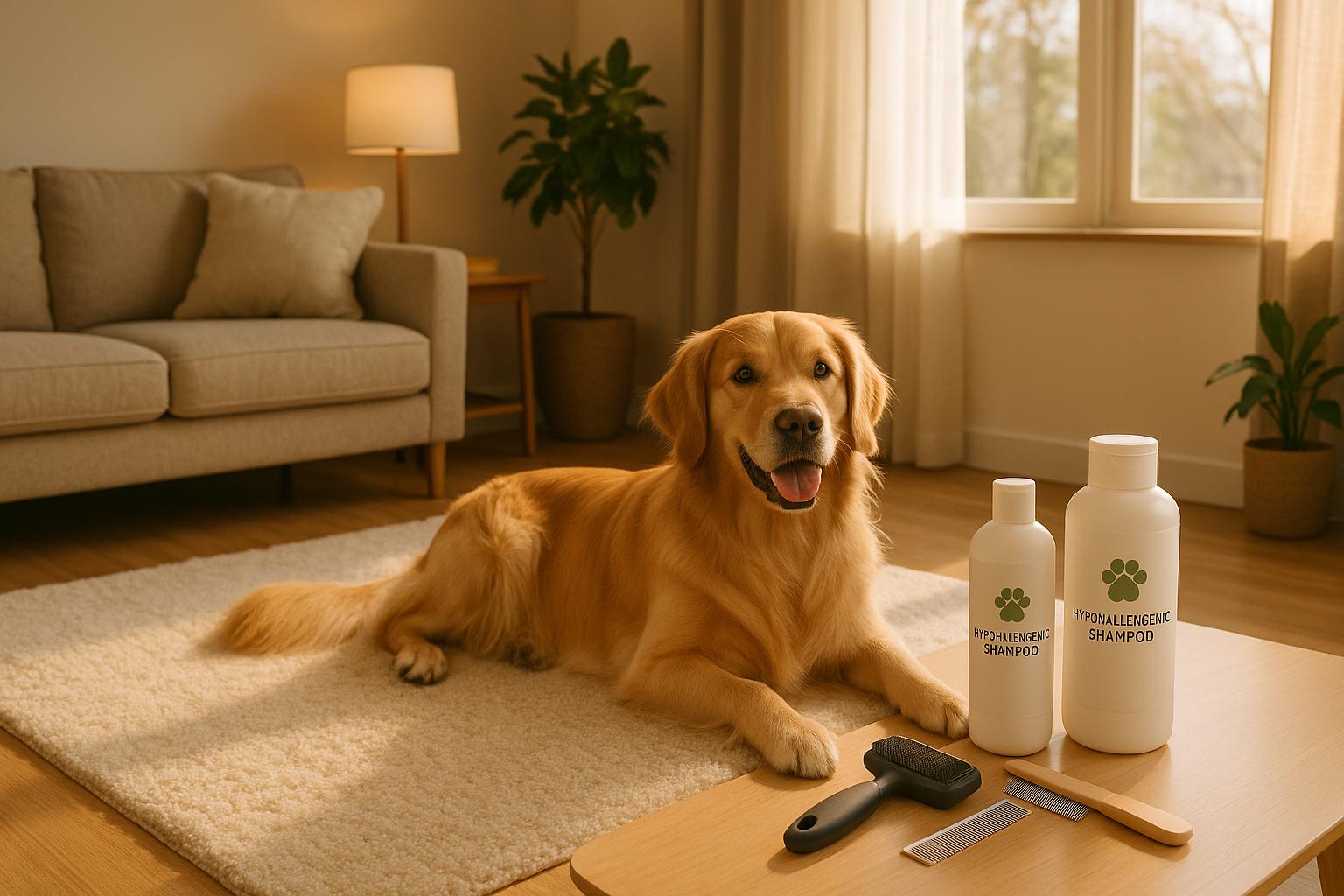
Pet Allergy Season: Complete Guide
Does your pet seem itchy, sneezy, or uncomfortable during certain times of the year? Pet allergy season can cause skin irritation, ear infections, and even breathing issues for your furry friends. Here's everything you need to know to keep them healthy and comfortable:
- Common Triggers: Seasonal allergens like pollen, mold, and fleas are the main culprits. Indoor allergens such as dust mites and cleaning products can also worsen symptoms.
- Symptoms to Watch: Excessive licking, scratching, runny noses, watery eyes, and chronic ear infections are common signs of allergies in pets.
- Prevention Tips: Regular grooming, vacuuming with HEPA filters, washing bedding weekly, and using air purifiers can reduce allergens.
- Supplements: Omega-3s, probiotics, and quercetin can strengthen your pet’s immune system and alleviate symptoms.
- Vet Care: Routine checkups and allergy testing can help identify triggers and create a treatment plan.
Quick Tip: Start with simple changes like bathing your pet with hypoallergenic shampoo and keeping your home clean. These small steps can make a big difference in managing allergies.
Want more details? Keep reading for a full breakdown of grooming routines, cleaning tips, and supplement recommendations.
Your Guide On Pet Allergies
Common Pet Allergens
Understanding what sets off your pet's allergic reactions is crucial for managing and preventing them effectively. Pet allergens generally fall into two categories, each requiring specific attention.
Indoor vs. Outdoor Allergens
Indoor allergens are often found in everyday environments. These include dust mites lurking in carpets and pet bedding, mold spores thriving in humid spaces, and irritants from cleaning products or synthetic materials. Interestingly, dust mites alone affect about eight out of 10 people in the United States, and pets aren't immune to their effects either. Pets can even be allergic to human dander or other animals in the household.
Outdoor allergens, on the other hand, change with the seasons. Tree pollen dominates spring, grass pollen peaks in summer, and ragweed takes over in fall, making spring and fall particularly tough for pets sensitive to pollen. Beyond pollen, insect bites - like those from fleas, mosquitoes, or ants - can cause reactions. Additionally, plants, grasses, and mold from soil or decaying leaves are common outdoor triggers for pets. These allergens can lead to a range of symptoms, depending on your pet's sensitivities.
Pet Allergy Symptoms
Spotting allergy symptoms in pets often requires close attention, as their reactions can differ from how humans respond. Skin-related symptoms are among the most common signs. Look for itchy or inflamed skin, excessive licking, or swollen paws.
Respiratory symptoms may include sneezing, wheezing, snoring, runny noses, or watery eyes. Chronic ear infections can also be a sign of allergies.
Digestive and systemic symptoms might show up as diarrhea, vomiting, or swelling around the mouth, ears, or eyelids. These symptoms can range from mild to severe, with some requiring immediate veterinary care.
"Allergens affect our pets in different ways, and your pet's symptoms will vary depending on the cause of his allergy."
It's worth noting that food allergies are relatively rare, making up only about 1% of all skin-related diseases in dogs. This highlights that environmental allergens are usually the main issue. Recognizing these symptoms is the first step toward identifying the specific allergens causing problems.
Finding Allergy Triggers
Pinpointing what triggers your pet's allergies involves a mix of observation and professional testing. Start by tracking symptoms: document when they occur, how severe they are, and any potential environmental factors like weather changes, new cleaning products, or outdoor activities.
For more precise identification, professional allergy testing is invaluable. Veterinarians can conduct IgE blood tests to identify specific allergens. Combining these results with a review of your pet's medical history and a thorough physical exam provides a clearer picture of what’s causing the reactions.
Timing plays a big role, too. Allergic reactions often don’t show up immediately; symptoms typically appear after the second or third exposure to an allergen. This delayed response can make it tricky to identify triggers without professional help.
If symptoms persist for more than two weeks, allergies are likely the cause rather than a temporary irritation. Severe cases - such as blocked nasal passages, difficulty breathing, or wheezing - require immediate veterinary care. Identifying these triggers is essential for implementing effective prevention and care strategies, which will be explored in later sections.
Grooming and Cleaning Routines
Keeping up with grooming and cleaning routines is key to minimizing pet allergens, especially during peak allergy seasons. These steps help remove allergens from your pet’s coat and home, creating a more comfortable environment for everyone.
Grooming Your Pet
Regular grooming is a simple but effective way to manage allergens. For short-haired pets, brushing once a week is enough, while long-haired pets benefit from brushing two to three times a week. This helps to remove pollen, dust, and dander that can cling to your pet’s fur.
Bathing your pet is another important step. Using a hypoallergenic shampoo, like Mighty Petz 2-in-1 Oatmeal Shampoo, at least once a month can help wash away allergens while keeping your pet's skin healthy. Pets with sensitive skin may need more frequent baths, but always use cool or lukewarm water to avoid irritation. After bathing, make sure to dry your pet thoroughly to prevent bacteria or yeast from developing.
For extra protection, consider using a moisturizing coat spray after brushing. This can help keep your pet’s fur hydrated and create a barrier against allergens. Pairing these grooming habits with a solid home cleaning routine will further reduce allergen buildup.
Home Cleaning Tips
Keeping your home clean is just as important as grooming your pet. Pet dander can linger in carpets, upholstery, and vents for weeks, so regular cleaning is crucial.
- Vacuum twice a week with a vacuum that has a HEPA filter. Focus on high-traffic areas like living rooms and bedrooms, and don’t forget spaces under furniture where dander can gather.
- Wash bedding weekly in hot water, and dust surfaces and ceiling fans. High-traffic walls can also collect allergens, so wipe them down with a damp microfiber cloth.
- Don’t overlook bath mats and towels. Wash these weekly in hot water, as they can trap allergens just like bedding.
Your HVAC system also plays a role in allergen control. Replace filters every 1–3 months with allergy-rated options (MERV 11 or higher), and clean dryer vents after every load. For a deeper clean, consider having your air ducts professionally cleaned once a year to remove hidden dander and allergens.
If allergens are still an issue, professional cleaning services can tackle hard-to-reach areas and provide a more thorough removal of pet dander than standard household methods.
Air Purifiers and Allergen Control
Air purifiers are another effective tool for reducing airborne allergens like pet dander. Models with HEPA filters are particularly effective, capturing 99.95% of particles as small as 0.1 microns - including pet dander, which typically measures 5–10 microns.
Activated carbon filters can also help by eliminating pet odors, offering a more complete air-cleaning solution. When choosing an air purifier, consider the size of your room and the unit’s noise level. Place the purifier near areas where your pet spends the most time, and make sure it’s not blocked by furniture or walls. Regular filter maintenance is essential for optimal performance.
Studies back up the effectiveness of air purifiers. A 1999 study found that air cleaners significantly reduced airborne dog allergens, and a 2011 study showed that participants experienced a noticeable reduction in allergy symptoms - 26% fewer in the morning and 24% fewer in the evening - when using air filters. While air purifiers can’t eliminate allergens entirely, they work well as part of a broader allergy management plan.
sbb-itb-0a789c7
Pet Health Supplements
Once you've tackled allergens through grooming and cleaning, the next step is to support your pet's health from the inside out. Supplements can bolster their immune system and help manage allergy symptoms. Since about 70% of a dog’s immune system resides in its gut, providing the right nutrition becomes especially important during allergy season.
Immune Support Supplements
Seasonal allergies can be tough on pets, but specialized immune support supplements can make a real difference. With canine allergies affecting an estimated 10–15% of dogs worldwide, targeted solutions are more relevant than ever.
One option to consider is Mighty Petz 10-in-1 MAX Allergy Immunity Chews, which combine 10 active ingredients in a vet-formulated blend. These chews include Omega-3 fatty acids, probiotics, and colostrum to address itching, strengthen immune defenses, reduce inflammation, clear airways, and help prevent infections.
Some key ingredients to look for in allergy supplements include:
- Quercetin: Known as nature’s antihistamine, it stabilizes mast cells, inhibits enzymes, and modulates inflammation.
- Probiotics and Prebiotics: These support gut health, which is crucial for a strong immune system.
- Turmeric: A natural immune booster with anti-inflammatory properties.
It’s important to keep in mind that supplements can help manage allergies but are not a cure.
Complete Health Support
Beyond allergy-specific supplements, multivitamins can help maintain your pet’s overall health during allergy season. For example, Mighty Petz 10-in-1 MAX Multivitamin offers a range of essential nutrients that promote immune function, healthy skin, a shiny coat, and general wellness.
Here are a few standout ingredients:
- Vitamins A, C, and E: These antioxidants help reduce inflammation and oxidative stress. Vitamin A also supports growth, eye health, and immune function, while Vitamin B aids enzyme activity and nervous system health.
- Omega-3 Fatty Acids: These are particularly effective for reducing itching, redness, and inflammation tied to allergic reactions.
- Functional Mushrooms: Known for their immune-boosting properties, they add another layer of support to a well-rounded formula.
Choosing supplements that address multiple health aspects ensures your pet is better equipped to handle environmental challenges.
Benefits of USA-Made Supplements
When selecting supplements, quality and safety should always come first. USA-made supplements often meet higher safety standards due to strict regulations and oversight. Facilities that follow Good Manufacturing Practices (GMP) are more likely to produce safe, high-quality products.
Supplements produced in the USA generally have stricter quality control compared to those made overseas, where regulations may be less rigorous. Given that pet supplement sales reached an estimated $580 million in 2016, ensuring quality is more important than ever.
Brands like Mighty Petz exemplify these standards by using carefully selected, high-quality ingredients and maintaining transparency about their sourcing and manufacturing processes. Look for products made with human-grade ingredients and free from artificial additives.
Before starting your pet on any supplement, consult your veterinarian - especially if your pet is on medication. Begin with smaller doses and gradually increase while monitoring for any adverse reactions. Always follow the recommended dosage and thoroughly review product labels to ensure you’re choosing natural, safe options for your furry friend.
These supplements work hand-in-hand with other allergy prevention measures to keep your pet healthy and comfortable.
Prevention and Lifestyle Changes
Beyond grooming and cleaning, small lifestyle tweaks can go a long way in protecting your pet's health and minimizing allergens in your environment. These changes don’t require major expenses or renovations - just a few smart adjustments to your daily habits.
Creating an Allergy-Friendly Home
The first step in reducing allergens starts with your home. Establish pet-free zones, like bedrooms or bathrooms, to keep allergens out of spaces where you spend the most time. To make these areas more effective, seal doorframes with weatherstripping or door sweeps to block pet dander from sneaking in.
Your choice of flooring can also make a difference. Hardwood or vinyl plank flooring is easier to clean and doesn’t trap allergens like carpets do. If replacing carpets isn’t an option, consider using washable area rugs that you can clean regularly. For furniture, opt for washable covers on sofas and chairs to make cleaning easier.
A consistent cleaning routine is equally important, especially during allergy season. Address moisture issues quickly by repairing leaks, using dehumidifiers, and cleaning with products designed to prevent mold, which can aggravate allergies. Combined with these efforts, regular veterinary care ensures you’re staying ahead of any allergy-related issues.
Regular Vet Checkups
Routine veterinary visits are vital for managing allergies in pets. Allergies can worsen or change over time, so regular checkups help your vet catch any secondary issues early and adjust treatments as needed. While most pet owners already schedule yearly visits, some pets - like senior dogs - may benefit from more frequent checkups.
Bixby Animal Clinic emphasizes the importance of consistent care:
"For pets prone to allergies, routine veterinary visits are not just advisable; they can be essential. Allergies can be unpredictable, evolving over time like shifting weather patterns. Without consistent monitoring, what starts as mild itching can escalate into chronic skin infections, respiratory distress, or digestive issues."
Your vet can also help identify new triggers and recommend medications or supplements tailored to your pet’s needs.
Tips for Allergy-Prone Owners
If you’re dealing with pet allergies yourself, these steps can help reduce your exposure:
- Wear a mask and gloves when grooming your pet.
- Wash your hands thoroughly after handling your pet.
- Use washable covers on furniture.
- Change clothes after spending time outdoors.
- Bathe your pet weekly with a gentle shampoo.
Keeping Pets Healthy During Allergy Season
Taking care of your pet during allergy season means focusing on grooming, cleaning, immune support, and prevention. These steps build on everyday routines to help keep your furry friend comfortable when allergens are at their worst.
Grooming plays a key role in managing your pet's exposure to allergens. Regular baths and brushing help remove allergens like pollen and dust that can cling to their fur. Don't forget about cleaning their ears and paws - this helps prevent infections and reduces the risk of allergens being ingested.
Creating a clean indoor environment is equally important. Using HEPA air purifiers can significantly reduce allergens in your home. For example, studies show that HEPA purifiers can lower cat allergen levels in bedrooms by an average of 75%. Running these purifiers continuously in high-traffic areas or where your pet spends the most time can make a big difference. Pair this with weekly washing of pet bedding and frequent vacuuming using a vacuum with a HEPA filter to keep allergens at bay.
To give your pet an extra layer of protection, consider immune-support supplements. A healthy gut can boost your pet's immune system, helping them handle allergens more effectively during peak allergy seasons.
The key is to stay consistent. You don’t have to tackle everything at once. Start with basics like grooming and cleaning, then gradually introduce supplements and air purifiers. Keep an eye on your pet’s symptoms and adjust your routine as needed.
For additional help, professional grooming services can complement your efforts at home. These services often provide deep cleaning and specialized treatments that can further reduce allergens.
"For optimal results, run your air purifier continuously in spaces where you spend the most time and where allergies are most troublesome. Many allergy sufferers report significant improvement when using air purifiers in bedrooms, creating a sanctuary for symptom-free sleep." - Windmill Air
FAQs
How can I tell if my pet's symptoms are caused by allergies or another health issue?
To figure out whether your pet's symptoms are caused by allergies or another health issue, watch out for signs like itching, sneezing, watery eyes, or skin irritation. These are typical allergy symptoms and often show up during specific seasons or after exposure to triggers like pollen or dust.
If you notice these symptoms happening regularly in certain situations - like after a walk outdoors or during spring and fall - there’s a good chance allergies are the culprit. However, if your pet is experiencing symptoms such as vomiting, diarrhea, or unusual tiredness, it might signal a different health problem.
For symptoms that persist or seem severe, such as wheezing, significant skin infections, or trouble breathing, it’s important to contact your veterinarian. They’ll be able to diagnose the issue and guide you on the right steps to ensure your pet stays healthy and comfortable.
How can I identify and reduce allergens that are affecting my pet?
To figure out what might be triggering your pet's allergies, talk to your veterinarian about allergy testing. This can help identify specific allergens that are causing problems. Keep an eye on your pet's symptoms - like itching, sneezing, or irritated skin - and note when and where these issues happen. Tracking patterns can provide valuable clues.
To lower allergen exposure, focus on keeping your home as clean as possible. Use a vacuum with a HEPA filter to trap allergens, wash your pet's bedding in hot water every week, and choose shampoos designed to reduce allergens when bathing your pet. Adding air purifiers with HEPA filters can also help by reducing airborne irritants like pet dander. These small changes can make a big difference in keeping your pet comfortable, especially during allergy season.
What are some long-term ways to manage pet allergies beyond seasonal care?
Managing pet allergies over the long haul means tackling the underlying causes and sticking to a plan that keeps symptoms in check. One option is immunotherapy, like allergy shots, which gradually help your pet build a tolerance to specific allergens. Another key step is making dietary changes, ensuring your pet gets high-quality, nutrient-packed food to support their immune system.
You can also focus on managing their environment. This includes keeping your home clean, using air purifiers, and regularly washing their bedding to cut down on allergens. Grooming with allergy-safe products is another way to reduce their exposure to irritants. Together, these steps can make a big difference in keeping your pet comfortable and improving their quality of life throughout the year.





